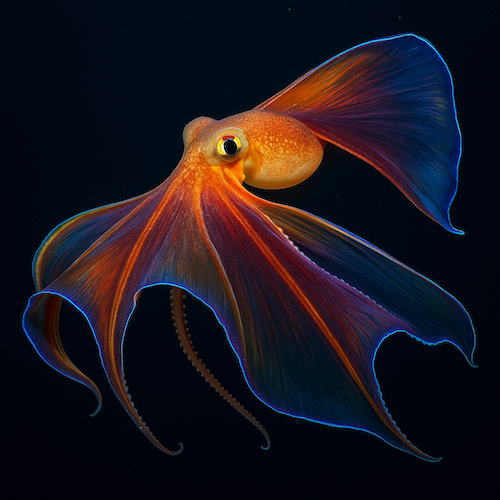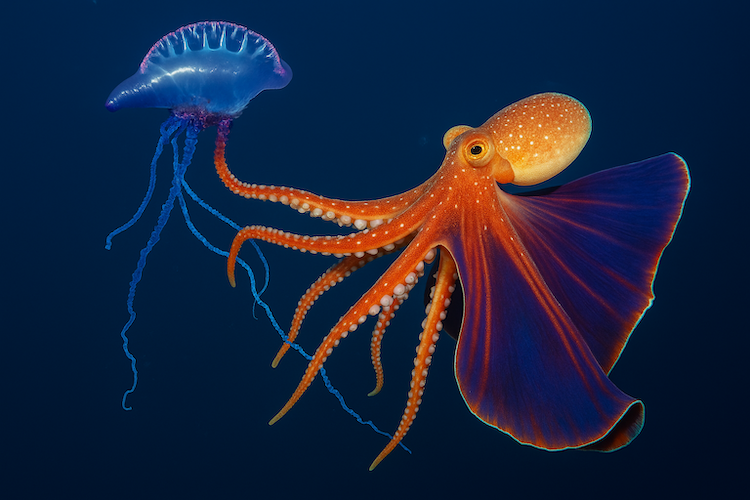octopus “The ‘Wonder’ Is What’s Under the Blanket” — a Glimpse of Wonder entry™ —
Some say the blanket octopus is different from other octopuses because it has eleven arms instead of the usual eight. That’s not true — but honestly, if it did, that might be one of the least surprising things about it.
Because the real differences? They’re far more astonishing than a couple of bonus limbs.
Let’s start with what the blanket octopus does share with its relatives — the octopus family is already full of mind-bending wonders. Like others in its group, it has three hearts — two to move blood through the gills, and one to pump it through the rest of the body. And when it swims? That main heart actually stops beating. So the more it moves, the more quickly it tires. It isn’t built for speed — it’s built for stealth.
Its blood isn’t red, either. It’s blue, thanks to a copper-based molecule that helps it absorb oxygen in the deep sea. Its brain is shaped like a doughnut and wraps around its throat — and most of its neurons aren’t in its head at all, but in its arms. That means its limbs can act independently, exploring and reacting almost before the brain checks in.
Octopuses in general are clever — problem-solvers, tool-users, sometimes even tricksters. Some have been seen unscrewing jars, stacking coconut shells, or disguising themselves in plain sight. Oh — and yes, they have eight arms, just like the rest of the octopus family.
That’s the kind of family the blanket octopus comes from — mysterious, flexible, quietly brilliant.
But now we come to the real differences.
Most octopuses, when threatened, have a go-to trick: ink. A sudden puff of dark liquid clouds the water, buying precious seconds to escape. It works as both camouflage and confusion — a natural smoke bomb in the sea.
But the blanket octopus? It doesn’t produce ink at all.
No smoke. No shadowy exit.
Which raises the question — if it can’t vanish in a puff of darkness, how does it defend itself?
Let’s start with the male — all one inch of him, fully grown and sexually primed.
He’s a speck, barely visible, smaller than a paperclip. You could balance him on your fingernail. He has no chance in a fight. No bulk to scare anyone. No cape to unfurl. But what he does have… is a weapon.
The male blanket octopus has been seen carrying the venomous tentacles of the Portuguese man o’ war — carefully plucked and held like electric whips. He uses them as a defense mechanism, waving them to warn off predators. Most creatures avoid the man o’ war at all costs. The male blanket octopus turns it into his personal stun gun.
And incredibly, he’s immune to the sting.
The female shares this immunity. She’s been observed using the same venomous tentacles — but not always, and not as her main strategy. She doesn’t rely on them. She doesn’t need to.
Because she has a slight advantage over the male.
She’s six feet long.
That’s not an exaggeration — it’s the most extreme size difference between sexes in the entire animal kingdom. She can weigh 40,000 times more than he does. For years, scientists thought males were just babies because they were so comically small by comparison.
 But the female doesn’t just gain size — she gains spectacle.
But the female doesn’t just gain size — she gains spectacle.
When she feels threatened, she unfurls her signature move: the blanket.
Delicate sheets of skin stretch between some of her dorsal arms — shimmering like silk underwater. This feature is unique to mature females. With a sudden motion, she can flare them out like a cape, making herself appear twice her size. The “blanket” can ripple with vibrant reds, purples, and blues, catching and reflecting light in the open water. If that doesn’t deter the threat, she can detach the blankets and leave them behind as decoys while she glides away.
And all of this — the entire display — takes place not on the reef, not near the shore, but in the open ocean, far from land or sea floor. The blanket octopus lives in the pelagic zone — a vast, drifting wilderness where almost no one is watching.
One is small and dangerous. The other is large and dazzling.
Neither has ink.
Both have a plan.
And Jehovah gave them exactly what they needed.
Even their meeting is quietly remarkable.
When it’s time to reproduce, the male uses a special arm — the hectocotylus — to transfer sperm directly into the female. In some species, including the blanket octopus, that arm actually detaches and stays with her, continuing its task even after the male drifts away, having fulfilled his purpose.
She stores the sperm until she’s ready to lay her eggs — hundreds or even thousands of them — anchoring them in a sheltered place deep in the sea. And then, she waits. She protects them. She cleans them. She fans the water over them to keep them oxygenated.
She never leaves.
And most of the time, she never eats again.
Her life — like his — is brief.
The male blanket octopus may live only a few months, just long enough to mature, mate, and vanish. The female lives longer, sometimes up to three years, but her story ends much the same: she gives everything for the next generation. Not in defeat, but in fulfillment.
When her young finally hatch, her task is done. And like the male, she dies — not in failure, but in quiet completion.
A single lifetime. A single mission. And yet, it’s enough to continue a line that goes back to the beginning of creation.
In Jehovah’s creation, greatness isn’t measured in size. The fully grown male blanket octopus could ride on the tip of a pencil — and yet, he’s equipped with one of the ocean’s most powerful defenses. His survival doesn’t come from bulk or strength, but from purpose.
Isn’t that how Jehovah works? Quietly, precisely, and sometimes unexpectedly — creating beauty where we least expect it, equipping the overlooked with exactly the tools they require.
If Jehovah puts this much creativity into a creature almost no one sees, how much more must He have in mind for you?
- Strawberrypeach, just1-4all, Amygdala and 5 others
-
 1
1
-
 1
1
-
 6
6


6 Comments
Recommended Comments
Join the conversation with your brothers and sisters!
You are posting as a guest. If you are already a member, sign in now to post with your existing account.
Note: Your post will require moderator approval before it will be visible.